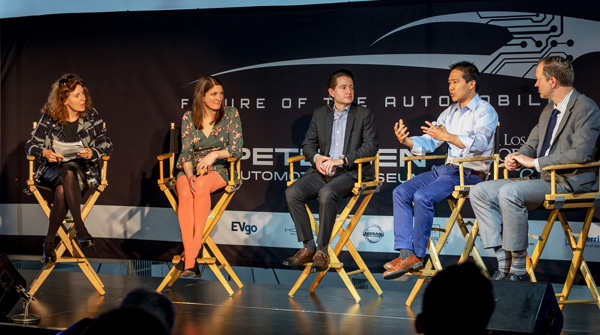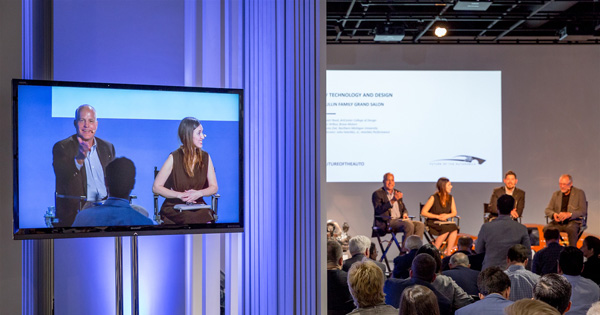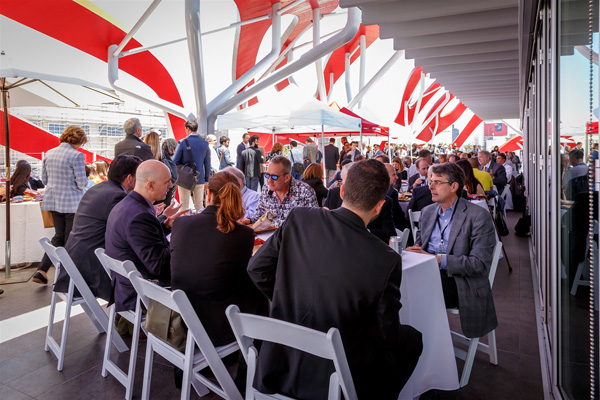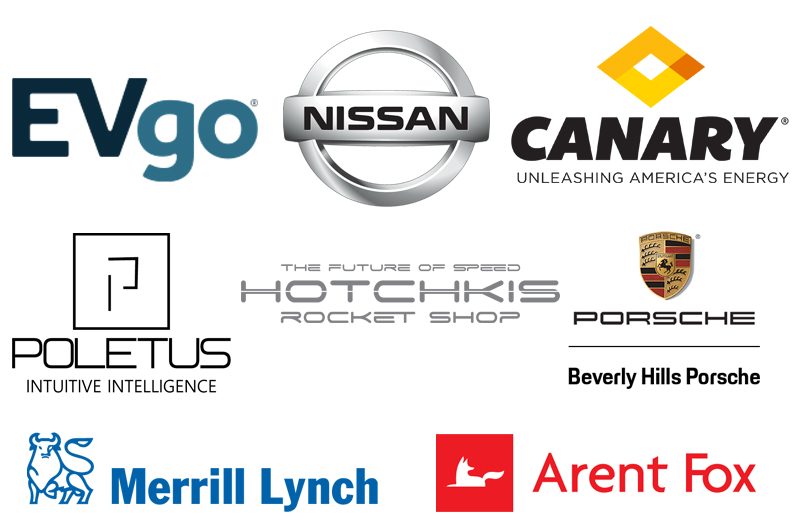 LA City Planners Design AV’S Future Panel with (L-R) Frances Anderton, DnA, KCRW, Ashley Hand, CityFi, David DeRosa, AECOM, Michael Lim, Global Transportation, Tech and Finance Advisor and Ryan Westrom, Ford Smart Mobility
LA City Planners Design AV’S Future Panel with (L-R) Frances Anderton, DnA, KCRW, Ashley Hand, CityFi, David DeRosa, AECOM, Michael Lim, Global Transportation, Tech and Finance Advisor and Ryan Westrom, Ford Smart MobilityThe Future of the Automobile Conference at the Petersen Automotive Museum, jointly hosted by the Petersen and the Los Angeles World Affairs Council on May 3rd, looked at the most cutting-edge technologies in the transportation field and aired informed and sometimes provocative speculation on the future. Speakers discussed how society as a whole will be affected by autonomous and electric vehicles, wide-spread ride-sharing and even the possibility of flying taxis, and how drone deliveries and underground freight tunnels could change the way we get our “stuff”. The overall takeaway? Things are changing fast, humans will want to maintain some degree of control throughout, and whatever happens China is already planning to be a major part of it.
The first panel had a rapid rotation of speakers with just 3 minutes each to make a point of their choice. Jeff Cole, the director of the Center for Digital Future at USC, opened by saying “driverless cars are the biggest innovation of the next 30 years.” He then listed “three lessons” from the tragic incident in Arizona in March when a woman was killed by an Uber car on autopilot, which he said illustrated why driverless cars were not doomed, despite the sad loss of life. First, he said, when the Wright Brothers started out, with multiple crashes, it was common for people to say “see, man isn’t meant to fly.” Secondly, he said the experiment in Arizona was not well designed by Uber. And thirdly, he noted that on the same day as that accident, “93 other pedestrians died in automobile accidents.”
Dan Eberhart, CEO of oil and gas company Canary, said that 29% of energy consumption in the US is for transportation fuel, and predicts that increasing electrification will bring down the cost of gasoline, thus prolonging the life of the internal combustion engine. Stefan Krause of EVelozcity pointed out that most electric cars on the road still look like combustion engine cars, which in turn look like carriages, and said that would likely change, while Kent Kresa, a former chairman of GM, said that when people no longer owned their own cars it would add an estimated $1 trillion to Americans’ disposable incomes.
Dakota Semler, the founder of Thor Trucks, said economics would force trucks to shift from diesel to electric, and Ryan Westrom of Ford Smart Mobility’s Greenfield Labs brought everyone back to earth by saying “it is important to remember that the human is at the center of the design equation.” Brian Witten from the cyber-security firm Symantec acknowledged the wide-spread fear that autonomous vehicles could be hacked, and said “there is no silver bullet” in cyber protection. John Rossant of NewCites and LA CoMotion said that the accelerating urbanization of the planet which is headed from 50% to 75% of the population living in cities only made the search for “better mobility solutions” more urgent.
The opening panel was followed by an hour-long discussion between Franz von Holzhausen, the chief designer of Tesla, and Jay Ward, who is the Creative Director at Pixar who made all the Cars films. Von Holzhausen said that he achieved his dream as a designer in starting with a blank sheet of paper to break out of the mold and create something completely new, in the shape of the Tesla Model S, rather than build some form of hybrid. “Hybrids are good on many levels, but they are not great – we wanted to be great!” He said the architecture of electric vehicles allows for some freedom in design, and said that although he started designing the Model S 10 years ago, “it still feels modern.” The key challenge for the Model S, which was competing at the premium level of the market with Audis and BMWs and Mercedes, was to be “beautiful and alluring, like a moth attracted to a flame – you are drawn to it even though you don’t know anything about it.”
 Jay Ward (left), Creative Director at Pixar and Franz von Holzhausen, chief designer of Tesla
Jay Ward (left), Creative Director at Pixar and Franz von Holzhausen, chief designer of TeslaAs for the smaller Model 3, which is now struggling to meet its production goals even as it gets rave reviews, von Holzhausen said it was “based on the idea of minimalism, that less is more,” with most of the buttons and instrument panel replaced by a single 15 inch screen. Ward from Pixar chipped in with the claim that “people don’t really give us credit for this but we did introduce the first autonomous vehicles!” in reference to the Cars movies. And he promised that a new serialized version of the Cars franchise would be coming out on Disney’s new streaming service next year.
On the Cutting-Edge Technology panel Rishabh Sharma, the founder of Poletus, said that his aim is “to paint a picture of Artificial Intelligence that is not scary but human focused.” Mory Gharib, the director of the Center of Automated Systems at Caltech, pointed out that 95% of all auto deaths are from human mistakes, and Sharma added “cars will be talking to cars soon – our lives depend on it.” George Karayannis, the VP of CityNow at Panasonic, said that “1/3 of the city is parking – is the glass half empty or half full? The glass is disgusting!”
On the Future of Racing panel it was acknowledged that the fan base for regular car racing at tracks is going down, and the sport needs to find new approaches to attract younger audiences. But even as autonomous driving becomes feasible, the overwhelming insight was that you cannot take the human driver completely out of the sport. “What people like about racing is the drivers,” said Rod Chong of Roborace, which is designing races with autonomous vehicles. “There will be some areas where it is too dangerous for humans – for example cars going backwards, or speedway racing with cars going in both directions.” But there will still be a need for humans to do the strategy, or for one human driver to lead a group of autonomous cars in a team on the track, he said. Terry Karges, the executive director of the Petersen Museum, said that although fewer people are going to watch car races at the track, live streaming means more people can watch online. And he pointed out that today drivers spend hours on simulators of their upcoming race before going to the actual track. “Racing is a showcase of technology and branding.”
The Future of Automobiles doesn’t stop with the vehicles – cities are thinking hard about what their futures will look like when AV’s become widespread. Ashley Hand, the co-founder of CityFi, told the LA City Planners panel that “the idea is that the Department of Transportation in the future is more of a mobility manager, thinking about how to manage an ecosystem of services,” including trains, buses, bikes, electric scooters and car shares. Los Angeles will be one of the trend-setters, said Mike Lim, who was an Executive Advisor to the City of LA on its connected and automated vehicle and infrastructure strategy. “LA has a lot of sway as the largest auto market, which gives us a chance to shape the country.” Ideas include making people pay for infrastructure as they use it, like charging drivers by the mile instead of imposing a gas tax, and giving citizens incentives to use public transport or carpool or travel at off hours, rather than always jumping into their own car for every journey they make. There is also the big issue of how new modes of transport could affect the geography of cities, with huge amounts of real estate currently used for parking lots and streets. “The greatest public land by acreage is streets,” said Ryan Westrom of Ford’s Smart Mobility Greenfield Labs. “Remember we have control of that space.” But David DeRosa from AECOM said that while it is “pretty hard to acquire a new right of way” in a densely-built city, “that constraint is alleviated when you go underground.” In addition to feasibility studies on tunnels, DeRosa said that building developers are already starting to think about air taxis as they design new buildings – defying the skepticism that many people have about being transported through the air in mini-helicopters.

In the Future of Trucking, Dakota Semler, the founder of Thor Trucks, and electric truck start-up, said that “the adoption of new technologies (autonomous and electric) will happen much quicker in the commercial world than in the passenger market.” Paul Rosa, SVP of Penske Truck Leasing which has 270,000 trucks on the road said “we know where we are going - how fast is it until we get there?... The industry thinks it will happen sooner than you think.” Rosa said Penske has already done scenario planning for large scale deliveries by drones – “we need to adapt to match customers’ needs.” Doug Bloch, a political director for Teamsters, said that “the only thing inevitable here is the technology,” and argued that “we need to prepare now for those 4 million drivers who will lose their jobs, and not wait until the jobs are gone and design a welfare program.” The panelists agreed that most trucking routes would be reduced to shorter hub-and-spoke models with each truck going less than 300 miles – an ideal distance for electrically-charged vehicles. And there was much interest in why legendary investor Warren Buffet had invested so heavily in truck stops around the country – what has he foreseen? Will the fueling bays be converted into charging stations?
The discussion on the Detroit Versus Silicon Valley panel produced a general consensus that it will be at least 25 years before today’s cars disappear and a completely new market emerges dominated by autonomous vehicles and ridesharing models. Russell Hensley who runs McKinsey’s automotive practice worldwide said that owning cars makes increasingly little sense, as we spend only 4% of our time in our cars, and the safety costs involved with human errors in driving amount to $300 billion a year. He predicted that “bigger change will happen on business models rather than purely on products,” pointing out that once cars shift to autonomous mode, personal ownership may no longer be routine. However Alex Roy, the founder of the Human Driving Association, said that there will be many people who, for different reasons, will be slow to change: for example people who have had to evacuate quickly from impending hurricanes. “I’ve been to Florida and New Orleans and Texas and there are people who would never give up car ownership for private rideshare.” And imagine how much ride sharing prices would surge when a Category 5 is heading in your direction. Rachel Nguyen, the director of Future Lab for Renault-Nissan-Mitsubishi, said “it’s not fun to drive anymore and it is cost prohibitive to buy a new car.” She said we are rushing headlong into ridesharing, but “everything seems to be for people who have means.” In this regard she saw a role for city governments to ensure that people of all incomes have some stake in what happens. As for the question about who would win out between traditional auto makers and the tech start-ups in Silicon Valley, Hensley pointed out that in the period between 2014-17 while the top four OEMs made 20 major investments to acquire related companies, the top two tech companies in the Valley made 170 investments…follow the money…
Aaron Jacoby, who heads the automotive practice for Arent Fox, talked to Bernard Soriano, the CIO of California’s DMV about Ethics and Regulations. Soriano said the DMV had been working on autonomous vehicle issues since 2013, and have currently approved 52 companies to test autonomous vehicles in California. “Our main focus is on safety, before regulation: we want technology to flourish in a way that keeps the public safe.” Soriano said there have been 65 reported accidents in California involving autonomous vehicles, nearly all of which were minor fender benders from the rear – usually because when an autonomous vehicle approaches a stop sign or a yellow light, it will actually come to a full stop, as opposed to human drivers who often do “rolling” stops. As to who will regulate AVs, the states or the feds, Soriano said up to now “the DMV has usually regulated humans while the federal government deals with the actual vehicles.”
 (Left to Right) John Hotchkis, Jr., Hotchkis Performance, Mounia Ziat, Northern Michigan University, Jason Wilbur, Brave Motors and Stewart Reed, ArtCenter College of Design
(Left to Right) John Hotchkis, Jr., Hotchkis Performance, Mounia Ziat, Northern Michigan University, Jason Wilbur, Brave Motors and Stewart Reed, ArtCenter College of DesignAV Technology and Design was moderated by John Hotchkis Jr., who pointed out that in the end, we all like to have the feeling of being in control. Mounia Ziat from Northern Michigan University said that “self-driving cars still need a sense of physicality,” which she compared to the sensation of riding on a horse. Even if the rider lets go of the reins, he or she can still feel the horse’s muscles and know all is well. The question is how to transfer that haptic sense that all is well when you are sitting in a car doing 60 mph when you do not have your hands on the wheel or your feet on the pedals. Jason Wilbur, the CEO of Brave Motors who make electric motorbikes and scooters, said “be careful about using technology for the sake of technology.” Stewart Reed who is in charge of Transportation Design at the ArtCenter College of Design said that “the original promise of cars was freedom – if these new solutions bring freedom that is fine.” The promise for the future of the car, Reed said, was “to still deliver art, beauty, joyfulness and an experience that is fulfilling.”
In the panel on The Future of Cars Around the World, Michael Dunne from Dunne Automotive said he had just come back from the Beijing Auto Show, which is now the largest in the world, and where there were 124 different electric vehicles on show – all Chinese. Dunne said few Americans have begun to realize the scale of the Chinese car market. Of the 90 million cars produced worldwide this year, 30 million will be in China. Chinese themselves will buy 28 million vehicles – and only 2% of those will be imported. And Chinese are not just buying cheap cars – China has by far the largest premium market, accounting for twice as many sales of Mercedes, BMWs and Audis as the US. “This has been contained in the US up to now, but this is about to change – all those Chinese automakers are getting ready to launch in the US.” Erik Antonsson, the CEO of aiPod who are developing autonomous transport systems for cities, pointed out that the “mobility revolution” is going to be mainly an urban phenomenon. “While cities are diverse in demographics and layout, their objectives are similar.” He said there is currently more traction in Europe as the population seems more open to shared mobility – and added that in Asia Singapore is very forward-looking in terms of AV operations.
“When does an automobile become an entertainment center? I see the windshield as a screen,” Ted Schilowitz, a futurist at Paramount Pictures, told the panel on AV’s Economic Future. “The customer wants their car to be attached to a technology ecosystem.” Evangelos Simoudis of Synapse Partners said the business model of cars will move from a transactional model “to others – like advertising to offer transport at a discount – or subscription models like Lyft and Uber – or commerce-based models” -shop while you are driven. “These models will emerge differently from different geographies,” Simoudis predicted. The panel suggested that ride sharing could actually make traffic worse as there could be an increased use of shared vehicles and a drop in the use of public transport. However younger consumers are already gravitating towards ride sharing, and autonomous vehicles will offer opportunities to be more productive while driving – checking emails etc.
At the end of the conference the talk at the rooftop reception was animated and loud. The conclusion was that change was coming so quickly and with so many companies moving into the mobility space, we better have another conference on the Future of the Automobile next year. See you then!


